I shot a roll with a twin-lens reflex camera (TLR) for the first time this month. But long before I used a TLR in real life, I loved the idea of it – so much so that I thought the reality was almost bound to disappoint. What camera could possibly live up to such high expectations? Enter: the Minolta Autocord.
Minolta Autocord: Overview
Chiyoda aimed for the fences with their new camera … and hit it out of the park.
—Mike Eckman
The Minolta Autocord is a fully-mechanical twin-lens reflex camera which takes 6×6 photos on medium-format film. Produced from 1955–66, the Autocord came in a number of variants. Some take 120 film only while others take both 120 and 220. Probably the most significant variation is that the L and CDS models have a light meter (selenium for the Ls, CdS for the CDSs). Other differences are relatively minor, like cosmetic changes to the nameplate or slightly different shutter speed sequences. All variants share some common features including a superb taking lens – a Rokkor 75mm f/3.5 with four elements in three groups (Tessar-type).
My model is an Autocord I, manufactured in 1965. It does not have a light meter, but I personally prefer the meterless Autocord variants (mainly for aesthetic reasons; I’m shallow like that). And I don’t mind shooting without a meter – sometimes I use a phone app, sometimes I just guess.
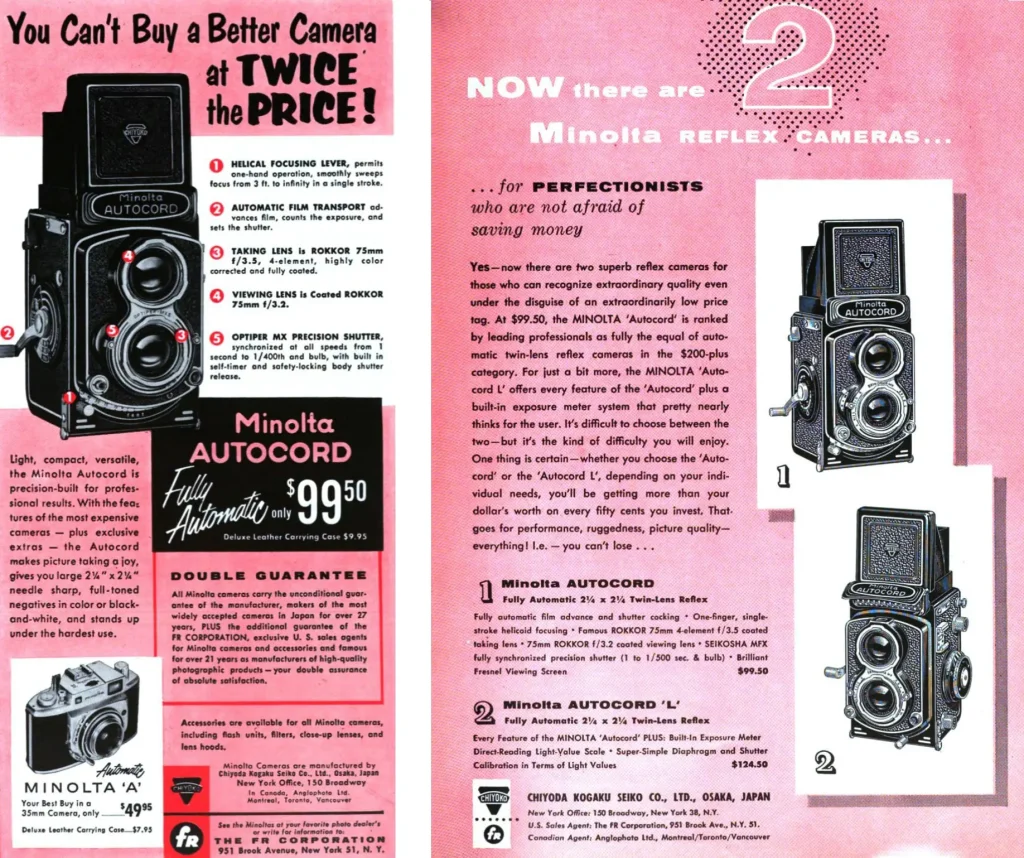
The Autocord and other TLRs
While I may one day add a high end Rolleiflex to my collection, … the Autocord does everything the Rollei does, and does it for a fraction of the price.
—Mike Eckman
Full disclosure: I’ve only shot one roll of film with my Autocord so far, so I’m not qualified to write a proper review. But most reviews I’ve read – e.g. Dante Stella, Mike Eckman, Casual Photophile, Tobias Key – praise the Autocord’s handling, design and build quality, reserving special plaudits for the Rokkor lens (which I’ll come to a bit later).
Meanwhile on the topic of disclosures, I also admit to a bit of a Minolta bias. My first “real” camera was my father’s Minolta SLR, still in regular use. I happen to think that compared to more famous brands like Nikon and Canon, Minolta’s 35mm SLRs and lenses were (and still are) underrated and underpriced – and I’ve always been partial to underdogs and good bargains. Funnily enough, the Minolta Autocord shares a similar fate, living as it does in the shadow of the Rolleiflex. A 1995 issue of Popular Photography included the Autocord in a list of “borderline cult cameras”. This is peak Minolta – not famous enough to be in the Rolleiflex/Nikon class; not rare enough to be a cult camera. Just “borderline cult”.
But I have no complaints; it keeps the prices down. I don’t know if the Autocord is “better” or “worse” than a Rolleiflex, but I do know that even a “low end” Rolleiflex was outside my budget, while my Autocord – purchased off eBay, fully functional and in decent condition – was much more affordable.
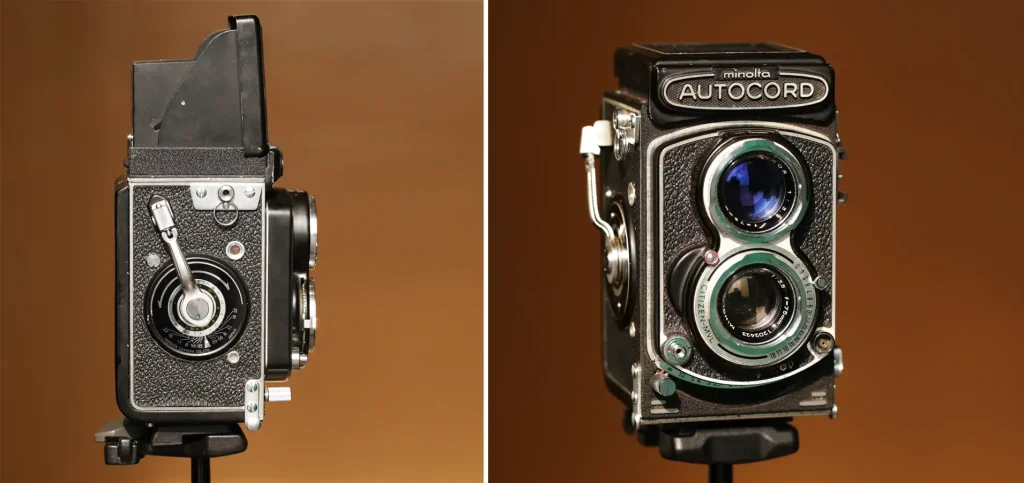
Autocord handling
…better optics, easier focusing, and a more logical control layout than any other TLR.
—Dante Stella
I’m not a professional, just someone who takes photos for fun. And to me, the experience of using a camera is just as important as the pictures. With no prior experience of using a TLR, I was prepared for all manner of difficulties, but it turned out that the Autocord is surprisingly easy to get used to. It’s kind of a vague thing to say, but the controls just “make sense” – or at least, they do to me.
If you’re looking down at the Autocord, the aperture lever, which I tend to set first, is on the left of the lens board. Moving it up lets in more light (wider apertures). The shutter-speed lever is on the right. Again, moving it up lets in more light (slower shutter speeds). The selected aperture and shutter-speed are displayed in little windows above the lens board – viewable from above when you hold the camera at waist-level, which of course is how it’s designed to be used.
Finder
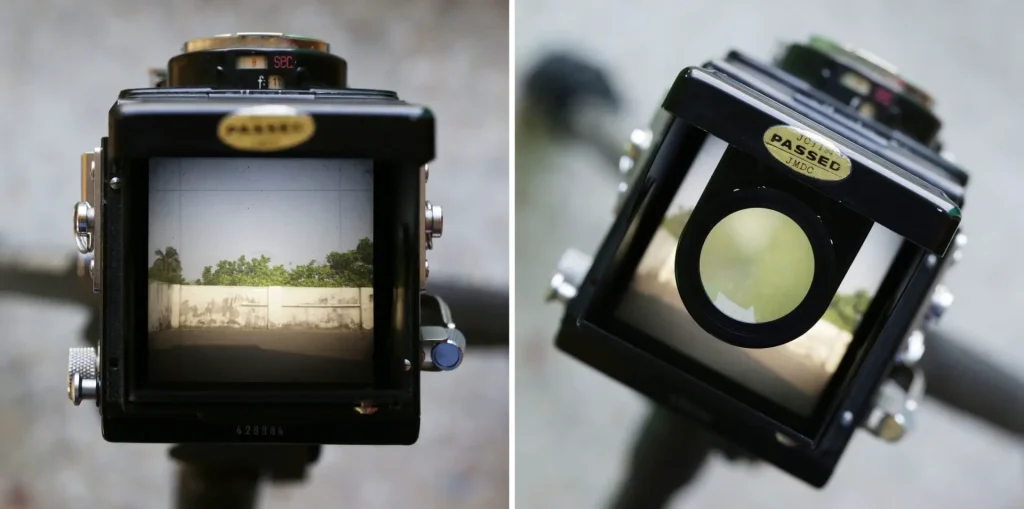
My focus screen looks deceptively good in these pictures, but in reality it’s a bit dim; I’ll probably get a replacement screen at some point. The dimness was more of a concern since I shot most of the roll – including all seven photos in this post – wide open, and the depth-of-field, as you’ll see, is pretty shallow. The magnifier (above right) was helpful, but when taking photos on the street, I did not always have time to use it. I was actually quite worried about focus issues, but luckily it turned out that I had missed focus on just one of the photos (and it was a pretty average photo anyway). Ironically, that one was shot at f/5.6. Go figure.
The Autocord also has a sports finder. This is an extremely simple device – basically just a square frame with a peephole behind it. It’s approximate at best, and there’s no focusing aid. On the plus side, it offers a direct, unmediated view of the scene, and of course, unlike the waist-level finder, it’s not laterally reversed. I have not used it yet, but maybe I will on the next roll, just for fun.
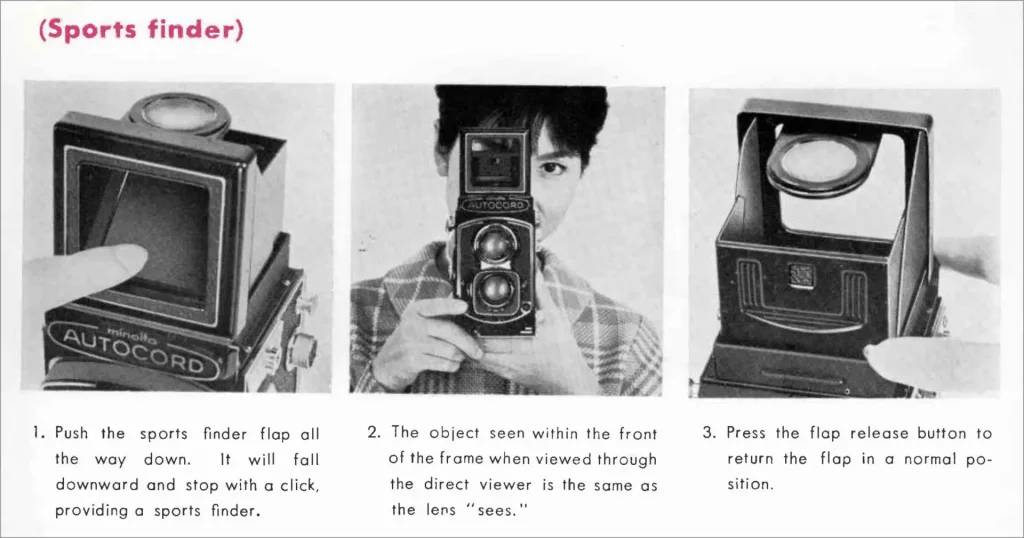
Other Autocord features include self-timer and multiple-exposure; I’m sure I will occasionally use these too. In fact, with the possible exception of the flash terminal, I don’t think there is a single feature which I will not use. Everything you need, nothing you don’t – surely there’s something to be said for that?
Film loading and advance
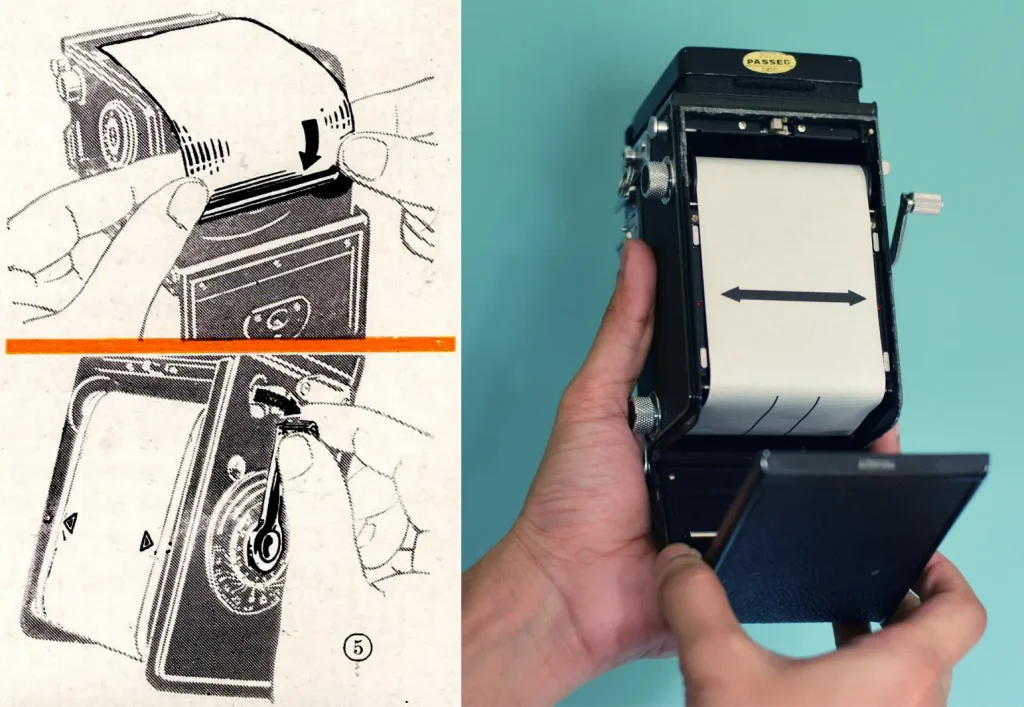
Loading the Minolta Autocord is simple if you’re used to medium-format cameras (in fact, it’s simpler than most). Insert a roll of 120 film in the upper chamber, feed the leader into an empty spool on the bottom chamber, advance until the arrows on the backing paper line up with indicator marks in the film chamber. If you’re interested, Herbert Keppler’s review in Modern Photography (1955) goes into more detail on the loading procedure and its supposed benefit over the Rolleiflex film-transport mechanism.
Film advance is with a crank lever on the right side of the body. The lever is a single piece of metal (not folding like the Rolleis) but it has a folding handle which can be docked into a bracket. To advance film, you “untuck” the handle, turn it forward (clockwise) as far as it goes, then move it back and tuck it back in. This manoeuvre – simple, fast and easy to get used to – also cocks the shutter and advances the automatic film counter.
The advance is smooth (at least on mine) and the little handle is spring-loaded which makes it easy, even pleasurable to use. I really appreciate such design features on cameras – or anything else, for that matter. Minor things maybe, but for me, they are evidence of the manufacturers’ attention to detail and user-centered design. Many such minor things, taken together, can make the difference between a camera which is merely alright, and one which is a delight to use.
Focus lever
An unusual feature of the Minolta Autocord, common to all versions, is the focusing mechanism – a protruding lever below the lens board (pictured below). Quite a few reviewers seem to think the lever is an ergonomic improvement over other TLRs, many of which have a focusing knob on the side of the camera. I haven’t used any other TLRs as I mentioned, but I can see where they’re coming from. With most TLRs, you would typically support the camera with your left hand while you advance the film with your right. Then you would switch hands – focusing with your left hand while supporting the camera with your right. With the Autocord, there’s no need for switching. With your left hand, you support the camera and operate the focus lever; with your right, you advance film and trigger the shutter.
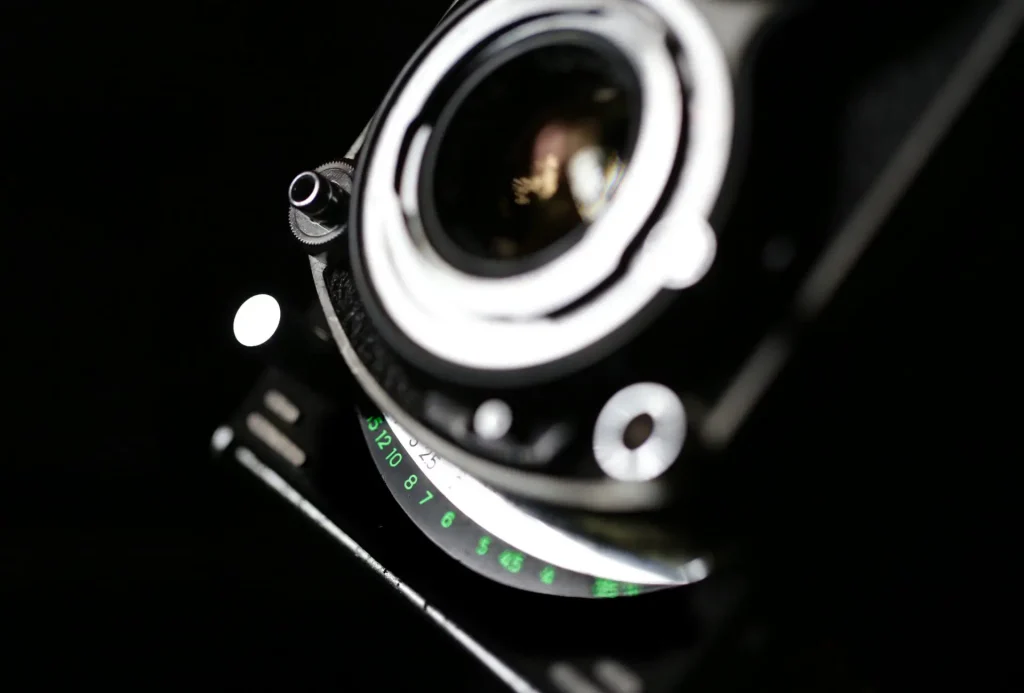
The lever is also convenient for zone focusing. The 6 o’clock position of the lever corresponds to 6 metres, and of course the two ends are the minimum focus distance (1 metre) and infinity. In this way, at some specific distances, I can now focus simply by feel without looking at either the viewfinder or the distance scale.
Unfortunately, the focusing lever is also one of the few weak points of the Autocord (that I know of). It is made of Zamak, a relatively brittle zinc alloy. Forcing a jammed focus lever can result in breakage. Quite a few Autocords on eBay have jammed or broken levers, so if you’re in the market, it’s something to watch out for. And of course, if your lever jams, get it lubricated; don’t force it.
Minor quibbles
Other quibbles with the Autocord – just mine, your mileage may vary – include the fact that the aperture lever is smooth with no detents (I like click-stops because you can set the aperture without looking – e.g. for f/8, go all the way to f/16 and then two clicks in the other direction) and that it’s quite close to the self-timer lever, which I have inadvertently set a couple of times when trying to change the aperture (more on this later). But these are minor things, I can get used to them.
Looks
it’s easy to fall into quiet contemplation as one admires … the combination of gleaming glass and polished metal.
—Casual Photophile
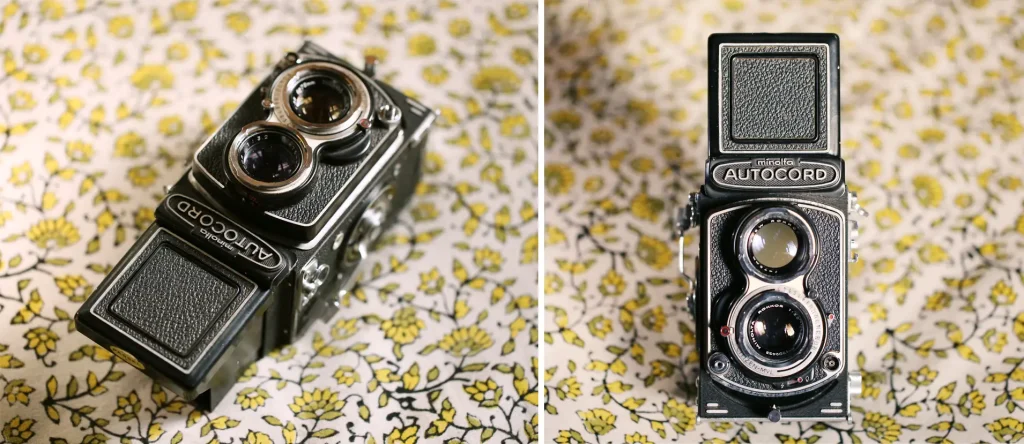
Black metal and leatherette, silver trim, knurled knobs, art deco curves. The Autocord is an incredibly pretty camera. What else can I say? Perhaps this stuff shouldn’t matter, but it does to me.
Autocord accessories
My motto is to go wild on the accessories.
—Heidi Klum
Minolta produced two sets of accessory close-up lenses – No.1: 40–65 cm, and No.2: 35–42 cm – but I don’t plan on getting them (sorry Heidi Klum). Part of my thinking behind getting a TLR was to have a simple, high-performance system with few choices – one where I think more about framing and composition, and less about what lens or accessory to use.
Fred Math lists various other accessories including the Autopole (a circular polariser which fits over both viewing and taking lenses and is coupled for synchronised rotation), Paradjuster (collapsible mount for parallax correction in close-up photos) and Panorama-Head (rotating mount with a spirit level, and click stops at 30° intervals designed for 12 pictures covering a 360° panorama). The Autocord is also compatible with Rollei Bay I mount accessories. But as I said, I plan to keep it simple. Famous last words?
I do however have a Kenko lens hood which came with the camera (and which I keep forgetting to use).
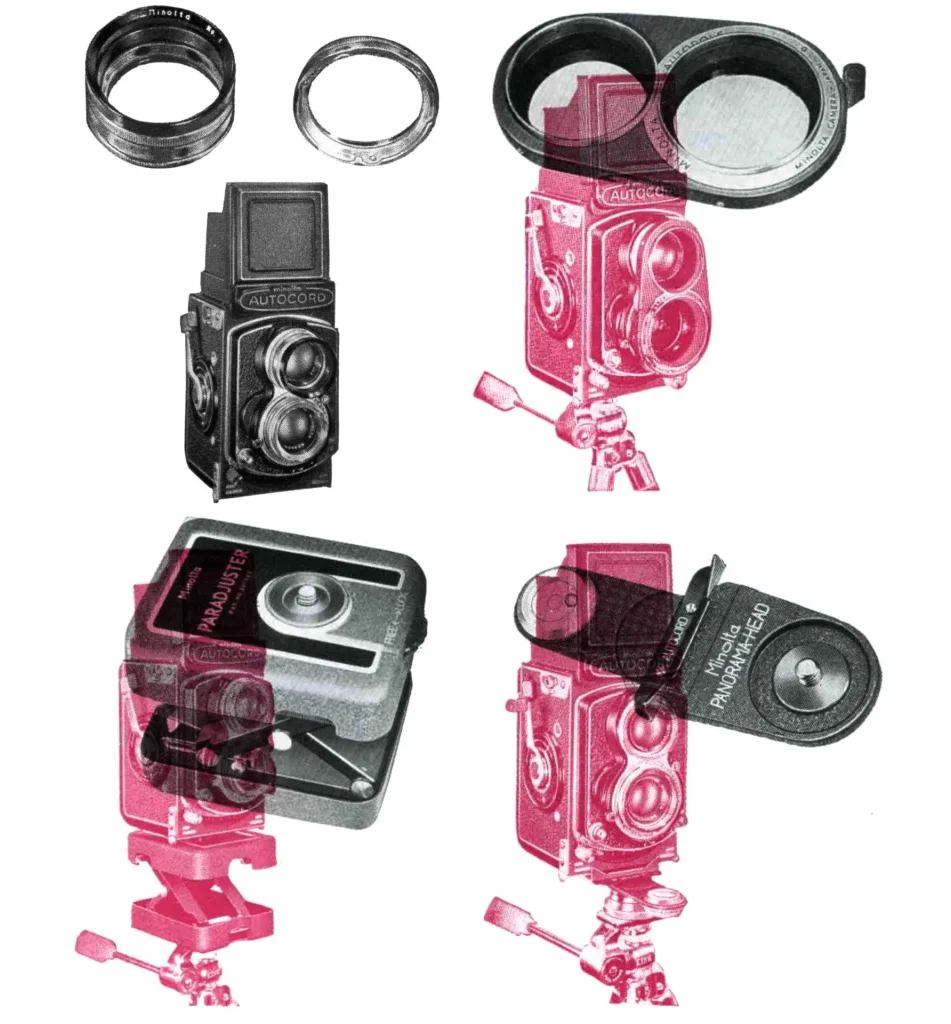 Autocord optics
Autocord optics
[T]he lens was performing as well as just about any twin-lens reflex lens we had ever tested.
—Herbert Kepper, Modern Photography (1955)
The Minolta Autocord is equipped with a Rokkor 75mm f/3.5 taking lens. From my online research I understand that all Autocord variants share the same lens design – a Tessar formula with four elements in three groups. (This Japanese website says the Autocord III and CDS models have a “New Rokkor” lens with high-dispersion glass, but I believe the lens diagram still looks identical.) The viewing lens – a three-element View Rokkor 75mm f/3.2 – has an amber coating in the older variants, and a blue coating in the newer variants from the Autocord I (my model) onwards.
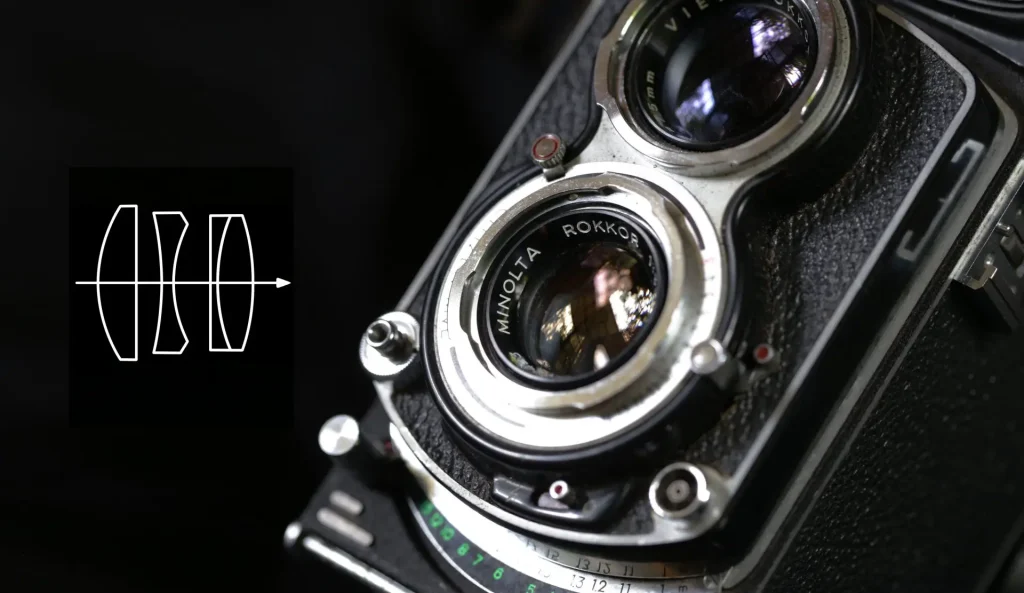
The Minolta Autocord’s 75mm f/3.5 lens has a similar viewing angle and depth-of-field as a 40mm f/1.9 lens on a 35mm/full-frame camera. The minimum focus distance is 1 metre (3.3 feet) – not very close by modern standards, but par for the course when it comes to TLRs. If you need close-up capability, you can get accessory lenses as I mentioned above.
As for the quality of the lens – I really like the rendering, and I don’t see any glaring flaws. Maybe that’s not much to go on, but at this point, I honestly don’t have anything more useful to say. What I have so far is a small sample of photos, all on black and white film, in a limited range of settings (mostly wide open, close focus, human subjects).
I also can’t compare with lenses on other TLRs since I haven’t used any. But other reviewers have, and Dante Stella claims that the Autocord’s Rokkor lens is sharper than the Rolleiflex Xenar or Tessar. But does that mean it’s equalled or perhaps surpassed by the Planar or Xenotar? The review does not say… For that matter, what does sharpness even mean? Do we worry about it too much? Is it just another way photographs can be?
Well… these are philosophical questions, and this is just a camera review. All I can say is, the Autocord is sharp enough for my needs. With a camera of this quality, at least in my case, the limiting factor is the photographer.
Autocord sample photos
depth of field game 10/10
—my friend Bronwen critiquing my Autocord photos on WhatsApp
I’ve only shot one roll with the Autocord so far: Ilford HP5 Plus 400 (my go-to film) which I developed in ID-11 1+1. Of the twelve photos on the roll, I got about six keepers. Admittedly my standard for keepers is not that high, but this is a better ratio than I generally manage on either medium-format or 35mm.
My first photo on the roll is of my mum. When trying out a new camera, I like to start easy, with a cooperative subject.
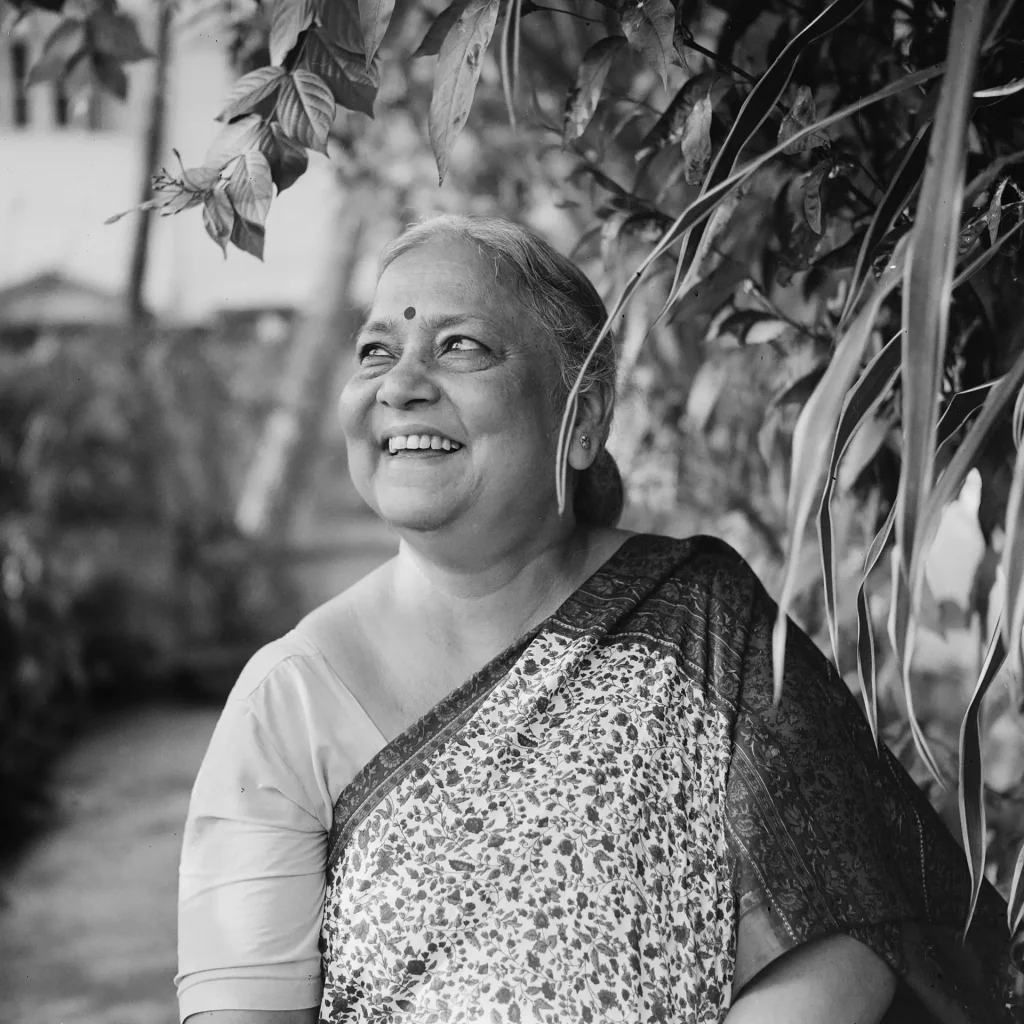
Everything went smoothly (though of course I could not see the result at the time!) and this gave me some confidence to do a “field test” taking pictures of strangers. The rest of the photos in this post were shot in the course of two afternoon walks in my hometown, Kolkata.
I don’t know if you’d call it “street photography” – some people reserve that term for candids, and only my last photo is truly candid. The rest are more like… “street portraits” I guess? Anyhow, when taking these types of photos, I usually chat to people – try and get them to relax, or do something interesting. And I’m useless at multitasking, so if I’m not comfortable with a camera, to the point that I can operate it almost without thinking, this approach doesn’t really work. But barring one or two glitches, my new-to-me Autocord gave me no trouble at all.
Kolkata is pretty hot at this time of year (the highest temperature today was 39°C), so I went out in the late afternoon when it’s cooler. The light is more flattering too; you can see the long shadows in the photo below. On the left of the frame, you can also see two goats which belong to the boy’s family. I took another picture of him with the goats, but that’s the one I mentioned earlier where I missed focus.

When I posted the photo on a film photography group, a fellow member commented that it’s a genre with a “with a deep heritage in photography,” linking to André Kertész’s 1928 photograph, Boy Holding Puppy (goes without saying, Kertész is in a different league; it’s just a fun parallel).
When I took the next photo, the light was failing and I was in a narrow alley. Consequently I shot wide open at 1/60 sec, praying for no camera-shake (luckily, it’s relatively easy to hold the Autocord steady, especially if you brace it against your body). At f/3.5 on a 6×6 camera, the depth-of-field is pretty shallow. I chose to focus on the dog, but the little girl had real “presence”. I’d like to go back and take a couple of portraits of her too, if I can find their house again. And I think I’ll make a print for her dad; I asked his permission before taking the photo, so I’d like to give them something in return.
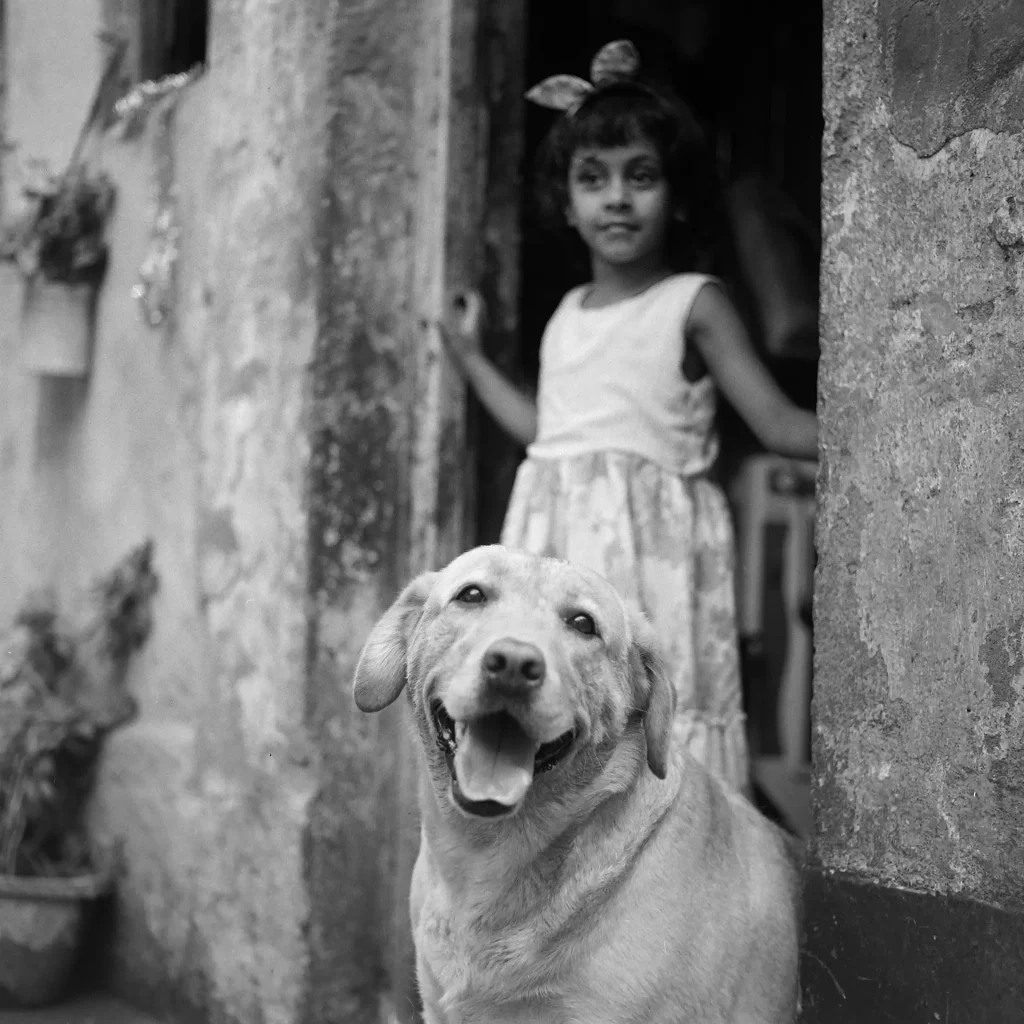
The ladies in the photo below are eating kulfi, a good way to beat the heat. One of them blinked, but I like the photo anyway.
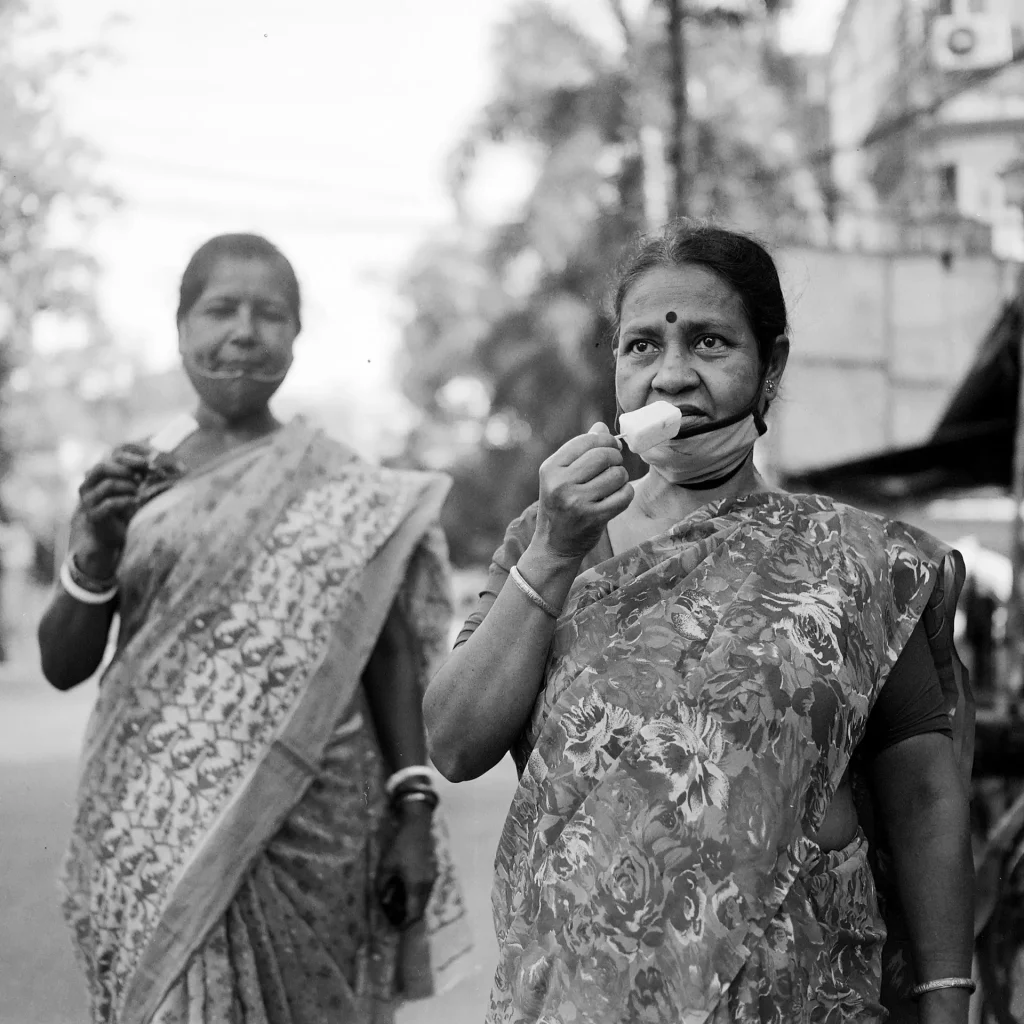
The next photo is one I’m not particularly fond of, and I initially didn’t include it in this article. But one of my photographer-friends really liked it and all but insisted I include it… so here we are. But it lets me illustrate something I mentioned earlier about the Autocord’s controls.
Before taking this photo, in trying to set the aperture, I set the self-timer by mistake (the two levers are rather close together). At this point, the sensible thing to do would be to close the lens cap, fire the shutter for a blank exposure, then use the double-exposure feature to cock the shutter without wasting film. But all this while carrying on a conversation was too much for me (did I mention I’m bad at multitasking?) So I just resigned myself to a ten-second lag, pressed the shutter and hoped for the best.
Well, it could be worse I guess. And I like the reflections on the steel utensils.
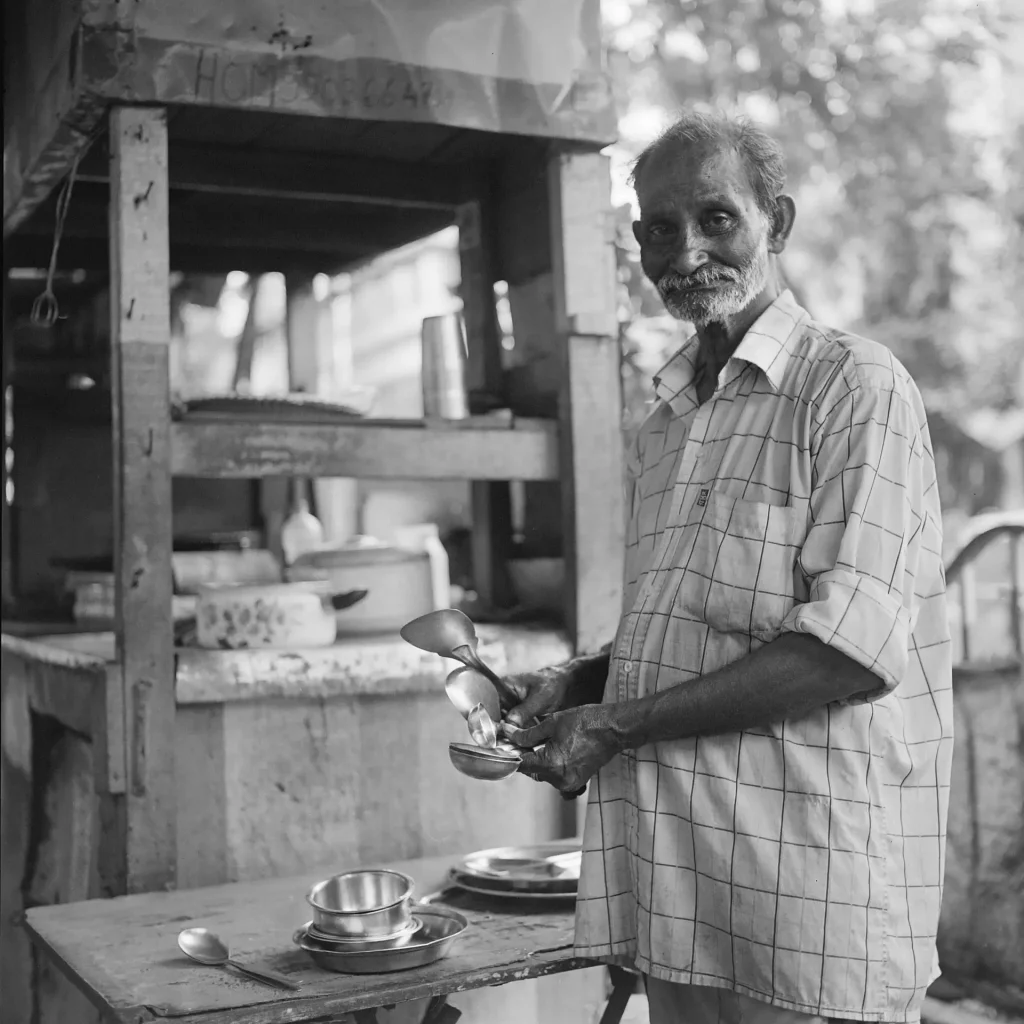
The next two photos feature the same kid. In the first one, I think the bokeh is a bit “busy”, but it doesn’t bother me too much. Then again, it looks smoother in the earlier kulfi photo, so before drawing any conclusions, I need to take more photos at different apertures and distances, and with a variety of out-of-focus backgrounds.
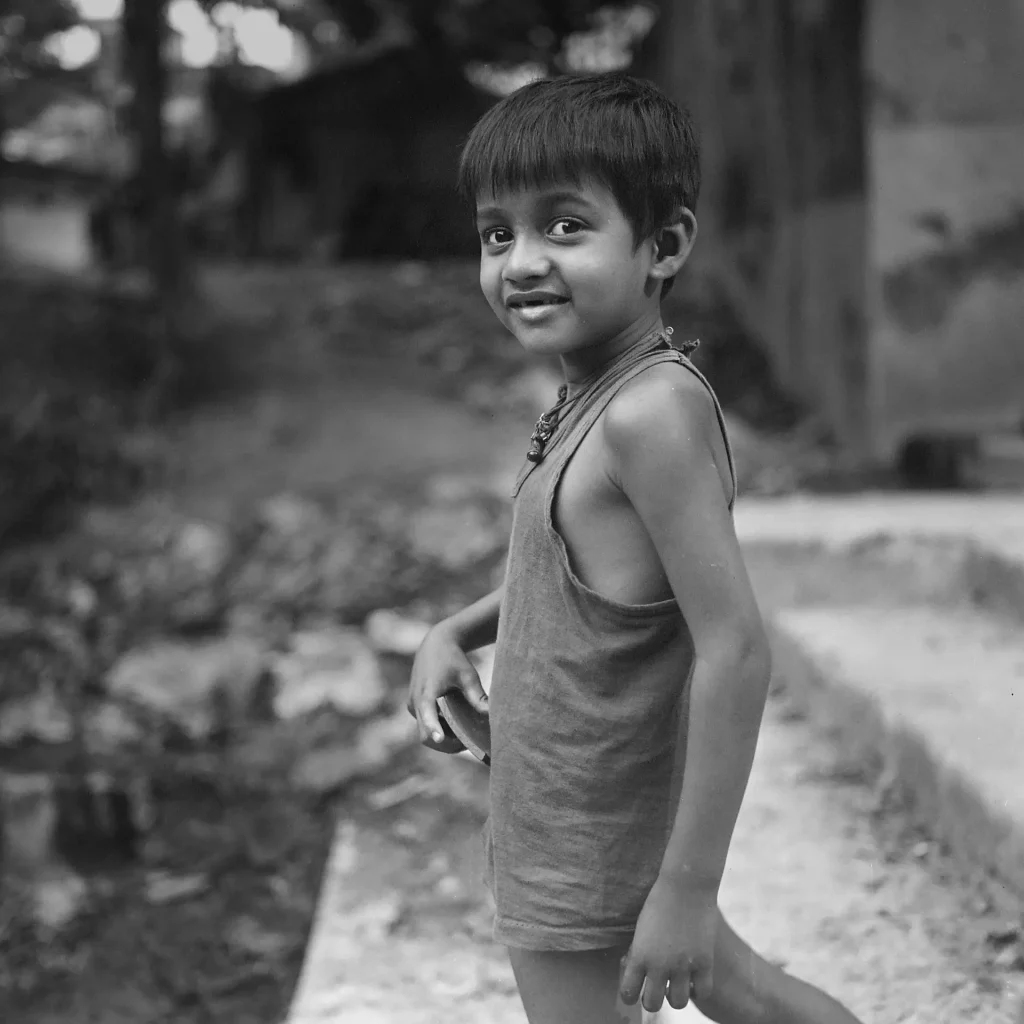
The next photo is the last one of the roll. I was running out of film and running out of light. I had to shoot at f/3.5 and 1/60 sec, which is why there’s a bit of motion blur – but I think it adds to the photo.
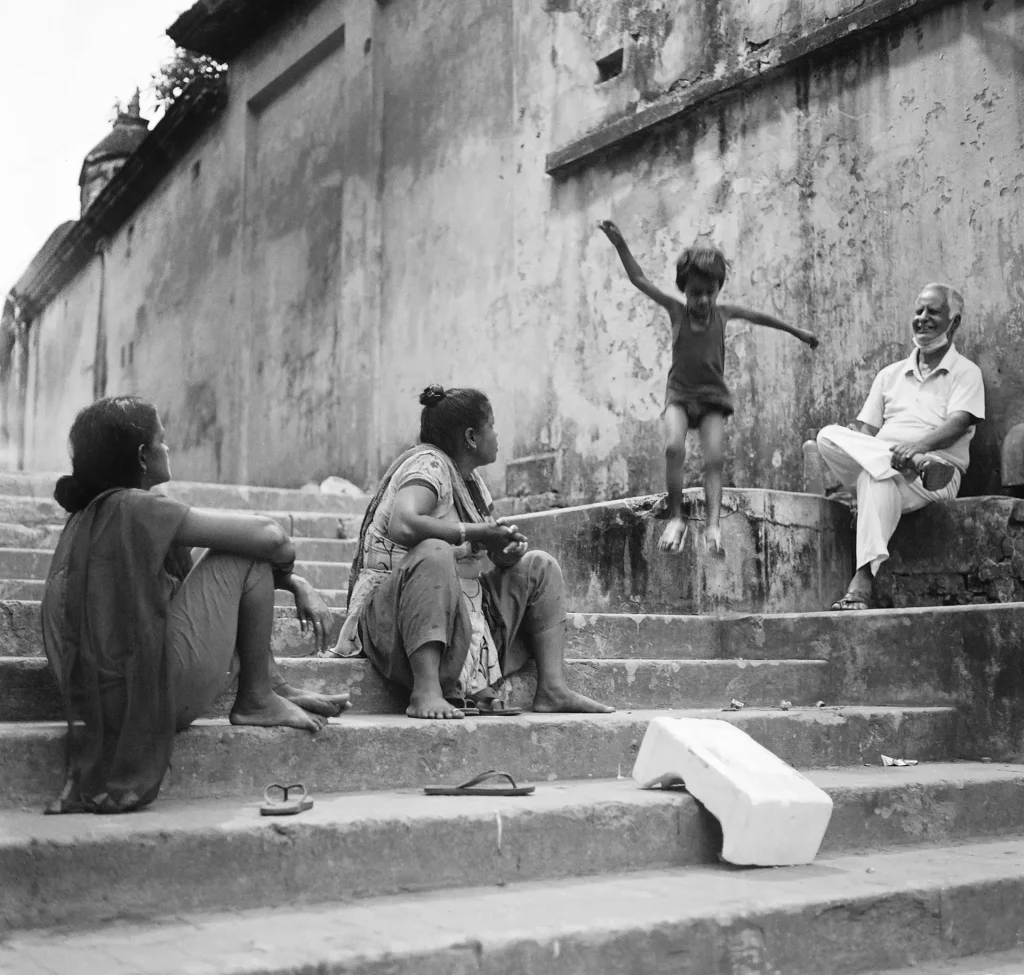
On a waist-level finder, as you’re probably aware, the image is reversed left-to-right like in a mirror, and this is generally regarded as suboptimal for action shots. To be fair, I’m somewhat used to this since I have an Ihagee Exa – a 35mm SLR with a waist-level finder. But the fact that I could take a “decisive moment” type photo with a new-to-me TLR is a testament to the Autocord’s ease of handling.
The kid noticed I was taking a photo and asked to see it. I explained that this is an old camera, so unfortunately we couldn’t see the picture right away, but if she was willing to jump again, I could take one on my phone.
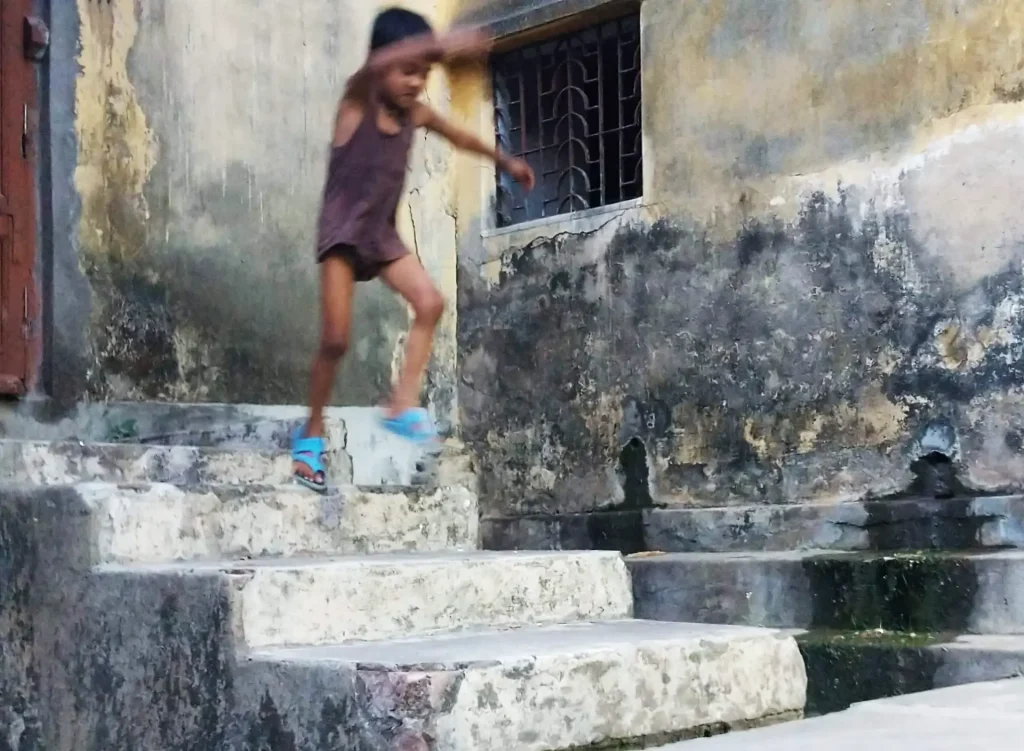
I showed her the phone pic (above) and she seemed pleased enough, but soon her attention shifted back to my Autocord. “What about the photo you took on this?” Cue more explanations, which she was not entirely convinced by. So I guess I need to make a print for her too.
A “human” camera
It was a fun little interaction, but also a good example of why I so enjoy shooting with the Autocord. Like most (all?) TLRs, there’s an undefinable “human” quality to its design. The little kid had probably never seen a TLR before. The older man who’s watching her jump probably had (he asked me if it’s a Yashica). But young and old, they were both curious about the camera – practically fascinated by it.
Maybe it’s the cuboidal form factor. Maybe it’s the shiny knobs and levers, or the twin lenses like Minions’ eyes. But I saw this time and again in my interactions with strangers. In the middle of their daily activities, they were willing, even happy to be photographed – playing with a stray puppy, jumping down stairs, eating kulfi. And I in turn could keep eye contact with my subjects and engage them in conversation – asking them what their dog is called, whether they like kulfi more or ice-cream – occasionally glancing down at the ground glass, and pressing the shutter when the time is right. The shutter is quiet, and there’s no mirror-slap. If I keep talking, often they don’t even realise when I took the picture.
Martine Franck once described the camera as “a barrier of sorts that one is constantly breaking down so as to get closer to the subject.” A TLR, I think, is less like a barrier; more like a bridge.
I look forward to taking many more pictures with my Autocord; if you’re interested, you can see the fruits of my labours on Instagram, or maybe here on 35mmc if I think of more things to write about. Thanks for reading.
Share this post:



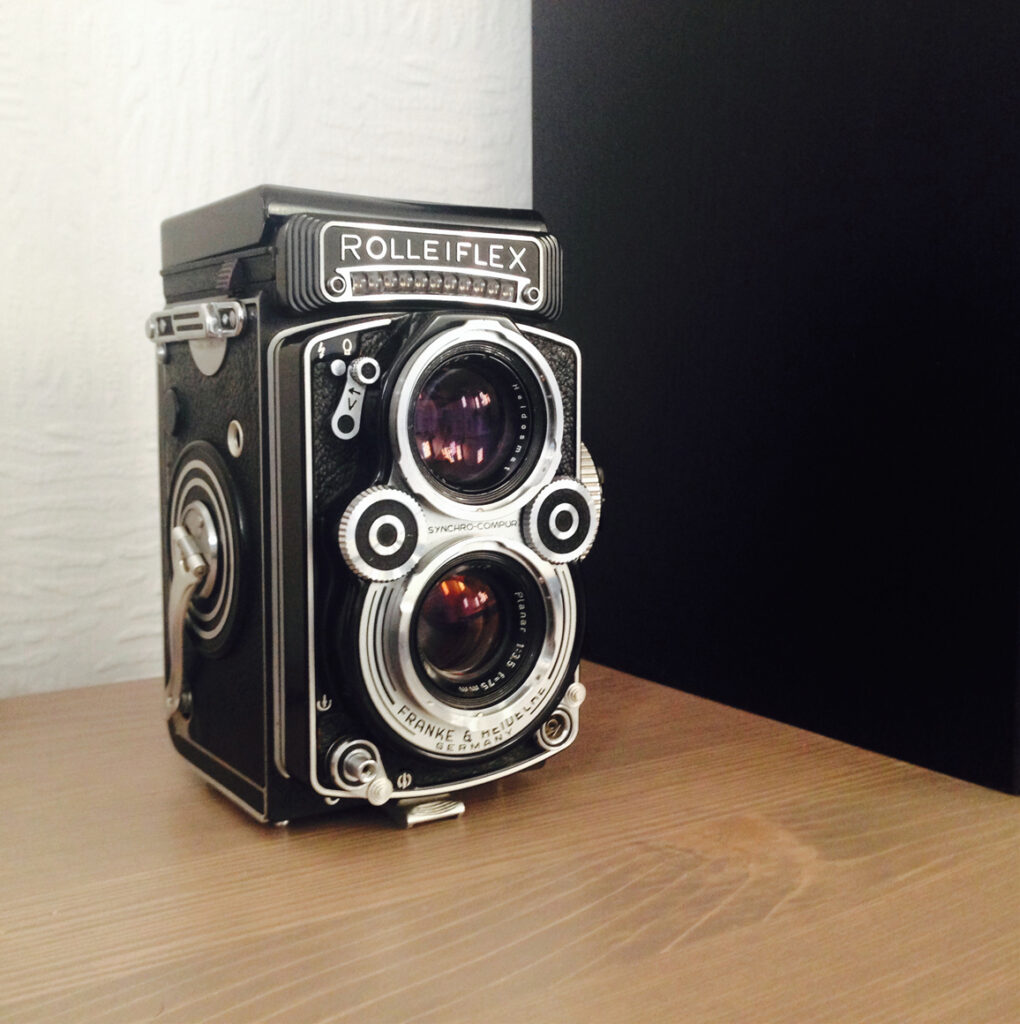
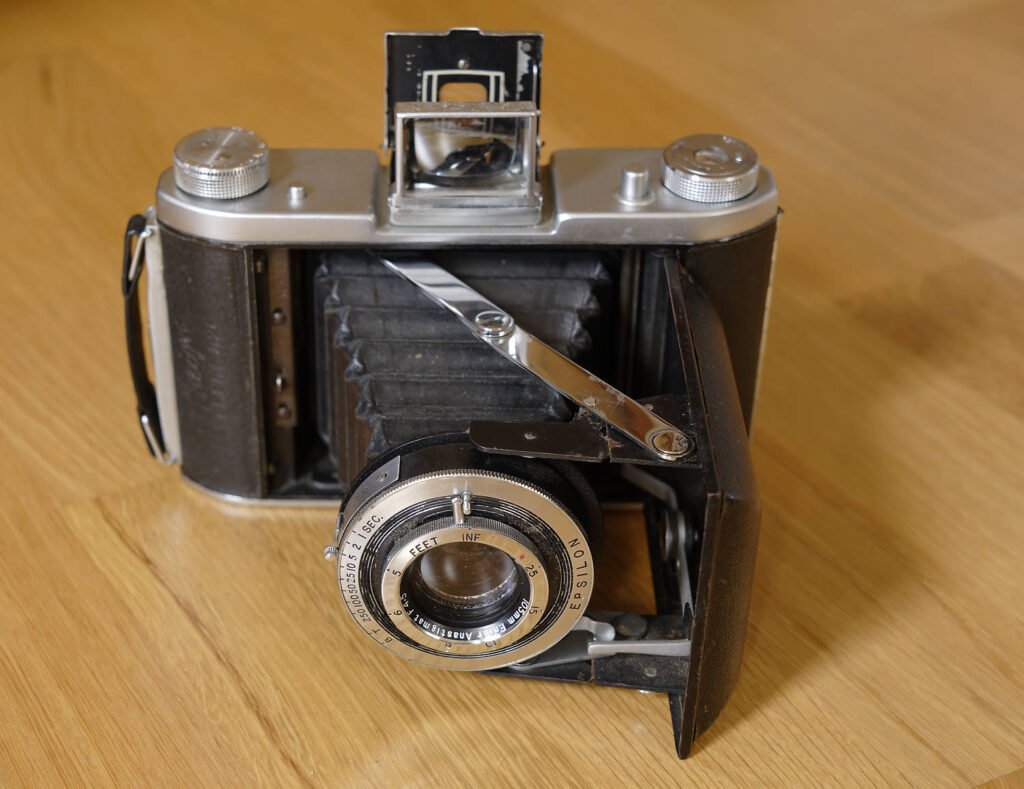




Comments
Patrice HENRION on Minolta Autocord TLR: First Impressions – by Sroyon
Comment posted: 24/05/2021
Your photos are superb.... and so is your approach to life. Congratulations.
Comment posted: 24/05/2021
Peter Roberts on Minolta Autocord TLR: First Impressions – by Sroyon
Comment posted: 24/05/2021
As you say, TLRs do seem to become a talking point when you are out and about with one. Sometimes this can be a great help, but sometimes a hindrance.
I had an Autocord many years ago and found it very easy to use, especially the lever for focussing. Something about that must be buried in my subconscious because I still find myself trying to use the non-existent one on my Rolleicord!
I love the images you've captured. They have a timeless traditional look to them. Marvellous.
Stay safe.
Comment posted: 24/05/2021
Comment posted: 24/05/2021
Comment posted: 24/05/2021
Bob Janes on Minolta Autocord TLR: First Impressions – by Sroyon
Comment posted: 24/05/2021
Comment posted: 24/05/2021
Comment posted: 24/05/2021
Comment posted: 24/05/2021
Kurt Ingham on Minolta Autocord TLR: First Impressions – by Sroyon
Comment posted: 24/05/2021
Comment posted: 24/05/2021
Terry B on Minolta Autocord TLR: First Impressions – by Sroyon
Comment posted: 24/05/2021
The Minolta Autocord is not a camera I've owned, or used, during a 40 year plus period in which I used 6x6 TLR's, from my first Yasicamat in 1963, to a Mamiya C330, then Rolleiflex 2.8E2, 3.5f, RolleiMagic II, and finally back to the last Mamiya variant, the C330S. (I still have this as well as the Yashicamat and Rolleiflex 3.5f and Magic II.)
I knew about the Minolta's focusing lever instead of the ubiquitous knob on most TLR'a, but the film path was new to me from this excellent overview, and I'd like to expand on your comment that it was felt to be superior to that of a Rollei, and Rollei derivatives. The same comment is made about Mamiya TLR's, although in these the film is wound from the bottom chamber to the take up spool in the upper chamber. But apart from the direction of travel, the same principle applies to both the Minolta and the Mamiya. The "advantage" referred to is that the film is not pulled around a roller before it reaches the film gate. Some felt that this could induce a kink in the film if it was left unwound over a period of time, and this may have an impact on film flatness, although it wasn't anything I'd experienced. With the Minolta it seems the film is pulled round the second roller after exposure, and with the Mamiya the whole film path is straight from upper to lower spool.
P.S. I love kulfi, especially pistacchio, after a balti or restaurant meal. Fascinating to see it on a stick!
Comment posted: 24/05/2021
CG on Minolta Autocord TLR: First Impressions – by Sroyon
Comment posted: 24/05/2021
Comment posted: 24/05/2021
Peter Grey on Minolta Autocord TLR: First Impressions – by Sroyon
Comment posted: 24/05/2021
Comment posted: 24/05/2021
John Duder on Minolta Autocord TLR: First Impressions – by Sroyon
Comment posted: 24/05/2021
The standout feature of the Minolta was the focus lever: I think that some MPP cameras shared the idea, and I liked it a lot. Though it's too far back for me to be able to compare quality with the Rollei, I think it was rather good...
Comment posted: 24/05/2021
Charles Higham on Minolta Autocord TLR: First Impressions – by Sroyon
Comment posted: 24/05/2021
Comment posted: 24/05/2021
James Evidon on Minolta Autocord TLR: First Impressions – by Sroyon
Comment posted: 24/05/2021
BTW, I liked your article. Very nice and complete.
Comment posted: 24/05/2021
solomab on Minolta Autocord TLR: First Impressions – by Sroyon
Comment posted: 25/05/2021
Comment posted: 25/05/2021
David Hume on Minolta Autocord TLR: First Impressions – by Sroyon
Comment posted: 25/05/2021
Comment posted: 25/05/2021
Ralph Turner on Minolta Autocord TLR: First Impressions – by Sroyon
Comment posted: 25/05/2021
Comment posted: 25/05/2021
Keith on Minolta Autocord TLR: First Impressions – by Sroyon
Comment posted: 25/05/2021
For those of us thinking of dipping a toe into the world of TLRs you've demystified the process a good deal with this piece of writing, even if you have likely made it a tad more expensive!!
Comment posted: 25/05/2021
Lee on Minolta Autocord TLR: First Impressions – by Sroyon
Comment posted: 25/05/2021
Comment posted: 25/05/2021
Matt Sandiford on Minolta Autocord TLR: First Impressions – by Sroyon
Comment posted: 25/05/2021
Comment posted: 25/05/2021
Comment posted: 25/05/2021
MIchael Jardine on Minolta Autocord TLR: First Impressions – by Sroyon
Comment posted: 26/05/2021
You did mention that you'd got hold of one of these funny little boxes and I was looking forward to the fruits of your first shootings. I've found it really easy to evangelise using a TLR for the way the experience of using it makes the pics come out. Put rather better by you, obvs.
Comment posted: 26/05/2021
Tim on Minolta Autocord TLR: First Impressions – by Sroyon
Comment posted: 27/05/2021
But, what I ended up really liking were the images you got. Fantastic pictures no matter what but particularly for a first outing with a new class of camera. Congrats.
Comment posted: 27/05/2021
Comment posted: 27/05/2021
Eric on Minolta Autocord TLR: First Impressions – by Sroyon
Comment posted: 04/06/2021
Comment posted: 04/06/2021
Geo on Minolta Autocord TLR: First Impressions – by Sroyon
Comment posted: 19/12/2021
Your mum's cheer really shows in the portrait, and it seems to have flown into your writing as well!
Comment posted: 19/12/2021
Le Minolta Autocord, sauvetage. | Michel LE MANDAT (mlmpages) on Minolta Autocord TLR: First Impressions – by Sroyon
Comment posted: 06/12/2022
cam on Minolta Autocord TLR: First Impressions – by Sroyon
Comment posted: 03/03/2023
Comment posted: 03/03/2023
GILBERT on Minolta Autocord TLR: First Impressions – by Sroyon
Comment posted: 23/03/2023
Comment posted: 23/03/2023
Leah de la Cruz on Minolta Autocord TLR: First Impressions – by Sroyon
Comment posted: 24/03/2023
Comment posted: 24/03/2023
Marcus Gunaratnam on Minolta Autocord TLR: First Impressions – by Sroyon
Comment posted: 04/04/2025